The Ultimate Guide to Circular Economy
Share:
10 drivers for circular economy
Let’s start with the benefits with a transition to circular economy. Why is it so important for the society, for companies and for individuals to start a transition NOW? The tips are inspired by a review of drivers for circular economy, in which you can find more information.
Drivers for society
The core of circular economy is to reduce the demand for resources. So, on societal level, I focus on presenting the benefits a circular system would have on environmental impact and on the eco-systems.

- Material efficiency – Growing demand of limited materials is leading to material shortages. Circular economy comes with solutions that reduce the material demand, still providing people with what they need.
- Emission reductions – Did you know that about 50% of the global carbon dioxide emissions can be traced back to material production? By reducing the material demand, emissions can be reduced and climate change can be tackled .
- Nutrition efficiency –The linear thinking in industrial food production systems is leading to nutrient poor soils and too much nutrients in oceans and lakes. Circular farming solves this by circulating nutrients in almost closed systems!
- Animal health – Reducing material extraction leads to less demand of land. This is good for wild animals, who today suffer from the way that humans transform their natural habitats.
Drivers for companies
Perhaps you consider adapting circular business models in your company and want to know what you can gain from it? Here are a few examples:
- Shifted customer demand – Future demand for sustainable solutions will affect customer preferences. By preparing for this, customer might choose your solutions over others.
- Long-term revenue – Many circular business models require disruptive change in the organization. The process can be costly initially, but lead to long term economic benefits. Making organizations independant of fossil fuels and materials can make them avoid increasing costs. Being able to capture material value and efficiently create value is what increases revenue.
- Staying ahead of legislation – Waste management policies will affect companies and how they can treat material flows in the future. By transitioning to circular solutions, companies can be prepared for upcoming laws and avoid unnecessary fines.
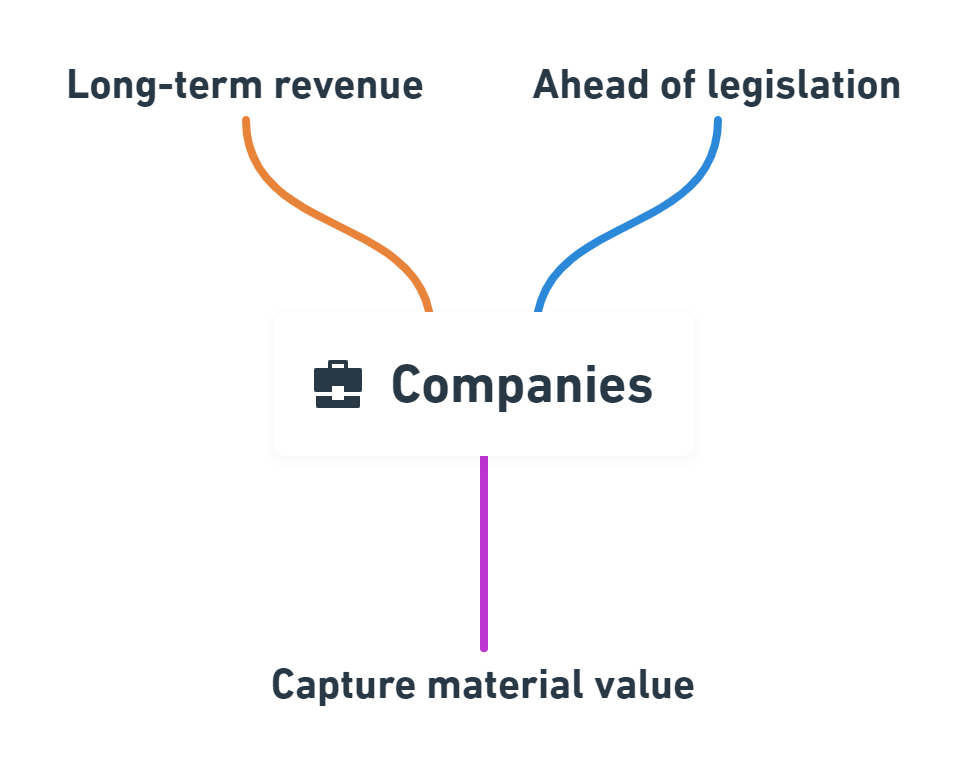
Drivers for individuals
Is circular economy relevant for you as an individual? The answer is yes! It comes with plenty of outcomes that can make life better for individuals. It is especially important for those who suffer most from the unevenly distributed wealth in the current economy:
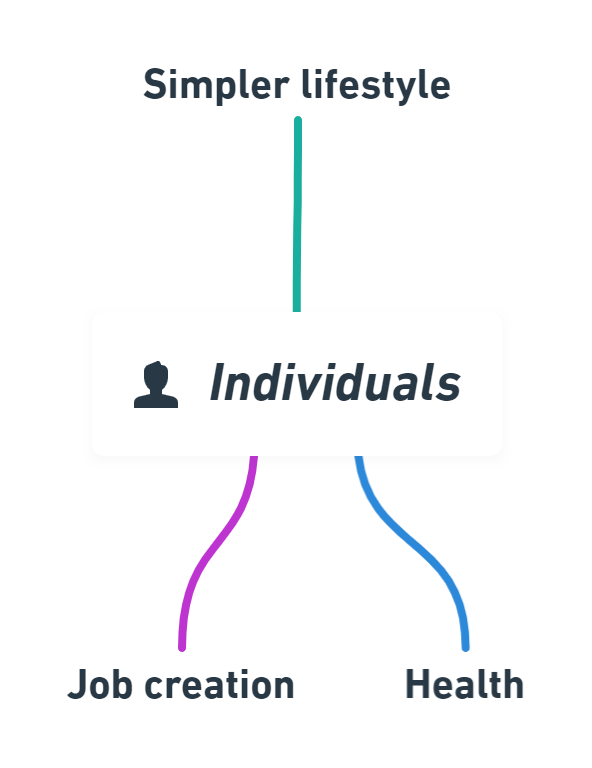
- Job creation – Circulating materials back into society requires more manual labour than automized, linear processes. A circular society will hence create job opportunities, which reduces unemployment rates.
- Health – In developing countries, human health suffers as a result of poor chemical and toxic management. Improved waste handling reduces spread of diseases and improve local water quality.
- Simplified Lifestyle – In a circular society, consumers do not have to own as many products. Instead, the responsibility stays at the retailer. This reduces both time and focus that you put into taking care of them and instead can do something more fun.
4 facts about circulating materials
Before continuing with aims with circular economy, there is some terminology I would like to introduce. Dont get scared, it is really straight forward, yet very important. The ideas were initially introduced by the Cradle2Cradle framework, which today also is a circular certification organ.

- Materials can be either technical or biological – The first thing you need to know is that materials can be divided into two “types”. It is important to be able to separate these two materials and you will soon understand why.
- Technical materials are often non-organic and non renewable – Some examples are metals, minerals, fossil fuel and non-organic chemicals. These can be found in the crust of the planet and are often mined.
- Biological materials are organic, renewable materials – These have been part of natural ecosystems for millions of years. Plants and animals are probably the most well known.
- Materials flow in technical and biological cycles – In a sustainable world (let’s say in a circular economy), materials would be divided into two cycles. And guess what, technical materials would flow in the technical cycle, while biological materials in the biological cycle.
8 important aims with the circular economy
Ok, so now that we speak the same language, let’s investigate what we want to achieve with a circular economy.
In the current economy, which can be referred to as a linear economy, we extract materials basically without circulating them at all. Materials are harvested from the nature and extracted from the earths crust. Then, we produce, use and discard them.
The following 8 aims give guidelines for how success in a circular economy can be achieved. They are also inspired by the Cradle2Cradle – design framework .
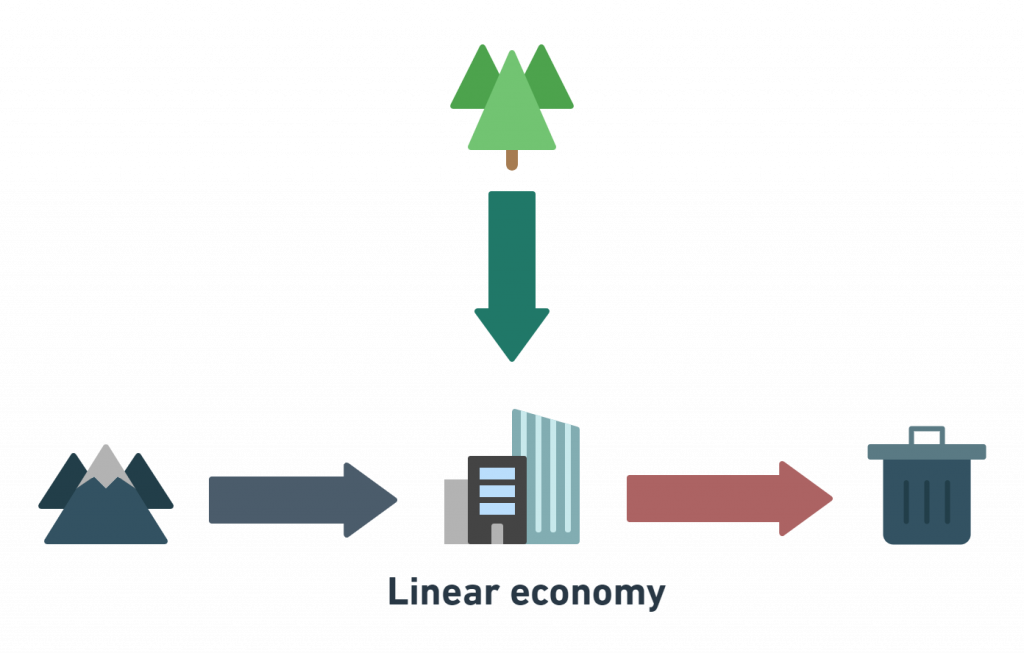
- Minimize material input – This regards both technical and biological materials. Reducing demand of resources might be the most important we can do.
- Minimize waste creation – We should avoid both pollution and creating material waste. Actually, in a circular economy we do not think waste, every material is a resource.
- Keep technical materials in society – Metals and chemicals should not end up in nature where they pollute and destroy the ecological balance. Circulate them as long as possible insted!
- Harvest biological materials in a regenerative way – Regenerative means that any harvesting is done in a limited pace. Slower than the pace in which it recovers. That way we do not harm the eco-systems.
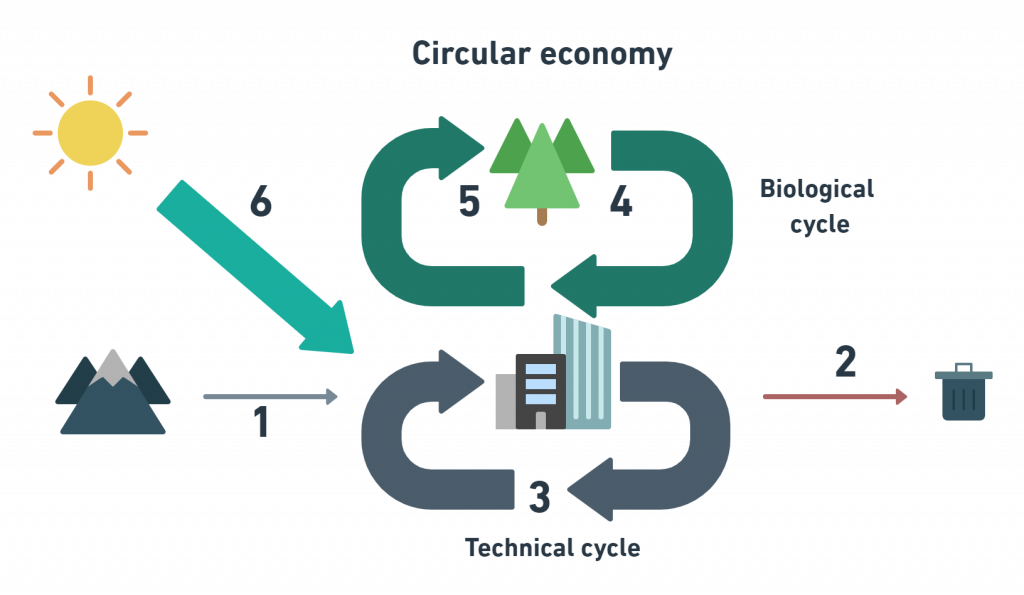
- Return biological materials to nature regenerative – Biological materials used in the society do not necessarely need to stay as long as possible. But when they are returned to the nature, it should be considered how it affects the ecosystems.
- Energy should come from renewable resources – This only works when the total consumption of materials and energy goes down though. Renewable energy depends on technical materials, which are limited. Production of power plants also emits carbon dioxide.
- Toxic chemicals should be avoided – Chemicals and other compounds that are dangerous for humans and eco-systems should be designed out, basically.
- Promote social sustainability – Circular economy initiatives should result in increased well-being, as all sustainability initiatives.
21 circular circular solutions
There are dozens of mechanisms/models/theories, described in circular economy literature. Many of them do however not focus on closing material loops. Some focus on making us depend less on resources while providing the same function. And some make material flows slower.
So, what do they have in common? They reduce the demand of materials and prevent waste production! In this guide I want you to get a more complete picture of the potential with circular economy by giving examples of circular economy throughout the whole value chain.
This categorization is based on RUTBECK – a regional circular economy project.
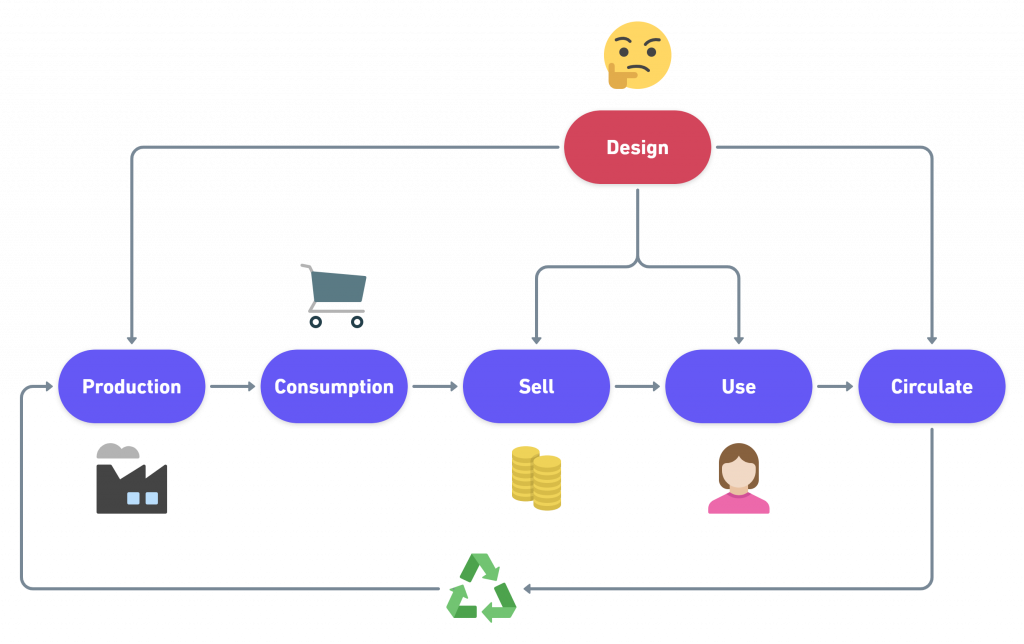
Circular design
According to some studies, about 80% of the environmental impact of a product is decided in the design phase. To succeed with these business models, preparation is required in the design phase. Here follow three important examples:
- Dematerialization – With the right design, alternative products can deliver the same functionality using less materials. Streaming services is a typical example of dematerialization. One drawback is that servers might demand more energy than the original solution.
- Modularity – Module based products enable many possibilities. Products can easier be repaired and parts of products can be replaced when they break. It is also easier to separate materials so that they end up where they should be. Biological materials should easily be separated from technical, for example. Cell phones are a good example of products where modularity is extra relevant.
- Increased functionality – Designing products that can deliver more functions than traditional offers opportunities to decrease material use. You can do a lot with your cell phone, reducing demand for watches or other gadgets, for example.

Circular Production
Efficient production is not only about reducing waste in manufacturing processes due to better technical solutions. In a circular economy every step of the production is optimized to minimize material use.

- Industrial symbiosis – Simply put, the waste of one company or manufacturer becomes the input to another. This requires collaboration between two or more actors and can save both material, energy and water consumption.
- Lean production – Resource efficient production by optimizing material flows, eliminating over production and minimizing inventory size.
- Production on demand – As it sounds, products are not produced before an order is received. Instead of pushing products on to people, people order the products they want. In some industries such as clothing, this can potentially lead to a high waste reduction.
Circular consumption
We have established that design is important for the environmental impact of products. But something that many forget is that high material flows originally occur because of high consumption rates. Regardless of organization, consumers can reduce material demand significantly by avoiding unnecessary consumption.
- Circular procurement – By focusing on what functions are needed in the public sector rather than what products, large amounts of materials can be saved. This is sometimes referred to as function procurement or green procurement.
- Slow fashion – Did you know that an average garment (at least in Sweden) is used 7 times before its thrown in the garbage? This concept aims at rethinking consumption by consuming few things that are used often and for a long time.
- Limited consumption – How does differ from slow fashion, you might wonder. Well, in this model, the consumer should ask her/himself if the function the product provides is really necessary. Or if it adds any function to their lives. It can be products where people tend to collect numerous products they can’t use at the same time. Who does not have multiple pillows, towels, cutlery for example?
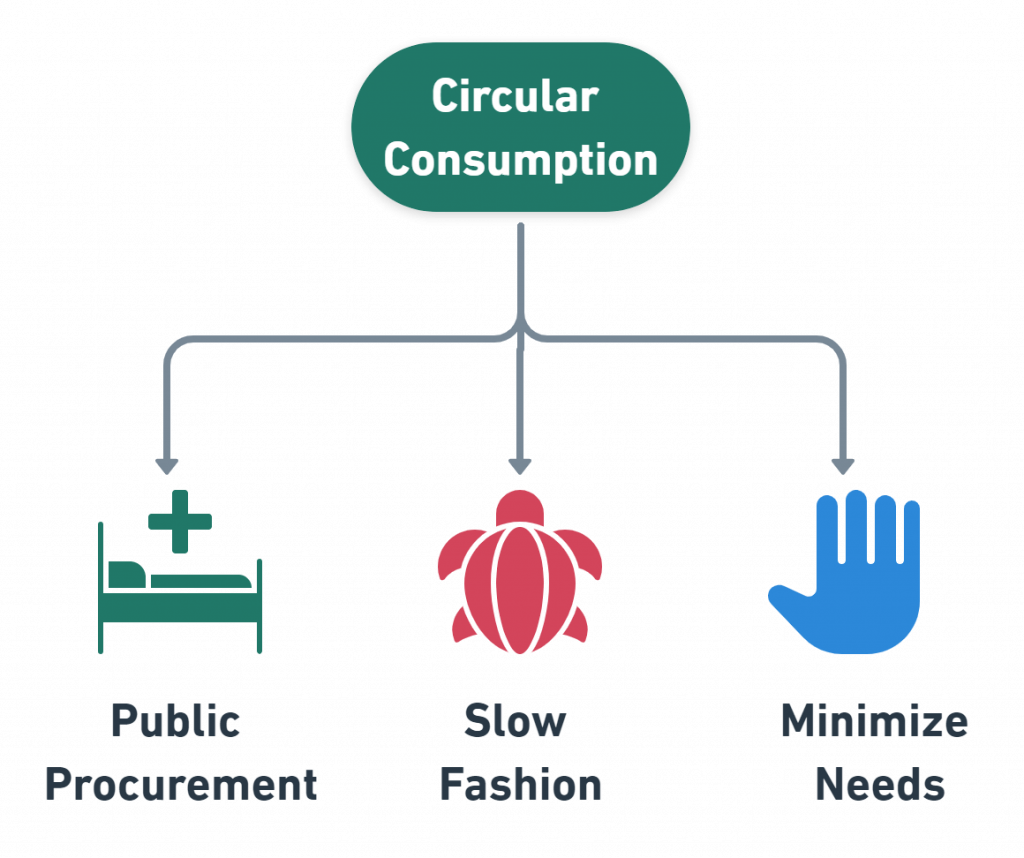
Circular retail
Not only consumers can think differently. Circular economy covers business models that target retailers as well. One concept is called Product Service System (PSS), which is basically to sell the function that products provide rather than the product itself. The target is to make more money and simultaneously reducing environmental impact.

- Sharing Services – You know about busses and trains, right? It’s a great example of sharing service, which also can be applied on cars (Über). Transport is a good example, the customer either pays for transport from one place to another, or for the time that they use a car. This reduces the need to own vehicles and other products, which saves material. It is especially efficient on products that are rarely used.
- Pay per use – Sell the service that the customers need instead of the products that provide the service. Selling printed papers instead of a printer, is one example.
- Subscription based service – Pay monthly or yearly to get a given service. Can be applied on IT-equipment, housing, music, video etc. It is a business model that allows the retailer to have a secure income over time, while keeping responsibility of products. It gives incentives to prolong the product life time, which we talk about in the next section.
Circular use
When you think about it, the most efficient way to save resources in the use phase of a product is to increase the lifetime of products. That way, less products have to be produced to replace the old ones. This can be achieved by:
- Repair and Refurbish – By repairing and refurbishing products they last longer. This requires quality products and often modularity which is covered in the circular design section of this guide.
- Repurpose – Taking damaged or old products or components and using them in new ones with a new purpose with minimal energy input. For those who have seen “do it yourself (DIY)” – videos, that is often a sort of repurposing. Two fun examples are: making a pot out of a broken boot or making a hook out of a bent wrench.
- Reuse – Instead of throwing things away, selling them or give them to someone (for birthday or Christmas!). Second hand is a great example of how reuse can work in practice. Both in physical stores and online.

Closing the loops
So, now we have reached the part of circular economy that I think most people know about. The part that is actually about circular flows. This is relevant when a product has been used and lost most of its value. Energy wise, it is actually often a last resort solution. But at some point all materials lose their value and the material has to be looped.

- Reuse and Remanufacturing – Taking parts of products and using in production of new, similar ones.
- Cycling – Taking parts of products and materials and putting them into other, different products. If the material is put in a product with higher value than before, it’s called upcycling. If the value decreases, it’s called downcycling.
- Recycling – Unlike cycling and reuse, this is a process where energy is needed to capture the material value. This is achieved by breaking it down to small elements. Often applied to packaging, where the materials are only used for a short period. But also to materials that have a high value, such as metals.
Bioeconomy
Bioeconomy is not specifically connected to the value chain of a product. By using the materials and processes that nature gives us, we can reduce negative environmental impact while demanding less resources! But it is important to treat products right both when extracting and putting back to nature.
- Cascading materials – Cascading means looping, using the maximum potential of the material. Example: A plank used for a building theoretically could be looped into a plywood board. Then a newspaper and/or into toilet paper, for example. It is a great way to save material, but comes with several technical challenges.
- Using renewable resources – Renewable materials are extra suited to use in consumable products such as packaging. Renewable energy in the form of bioenergy has the benefit that it’s unlimited as long as we preserve the ecosystems.
- Replacing toxic chemicals with organic materials –Today many products contain toxic materials that are harmful to humans and ecosystems. By using natural occurring materials, we can make materials flows safe.
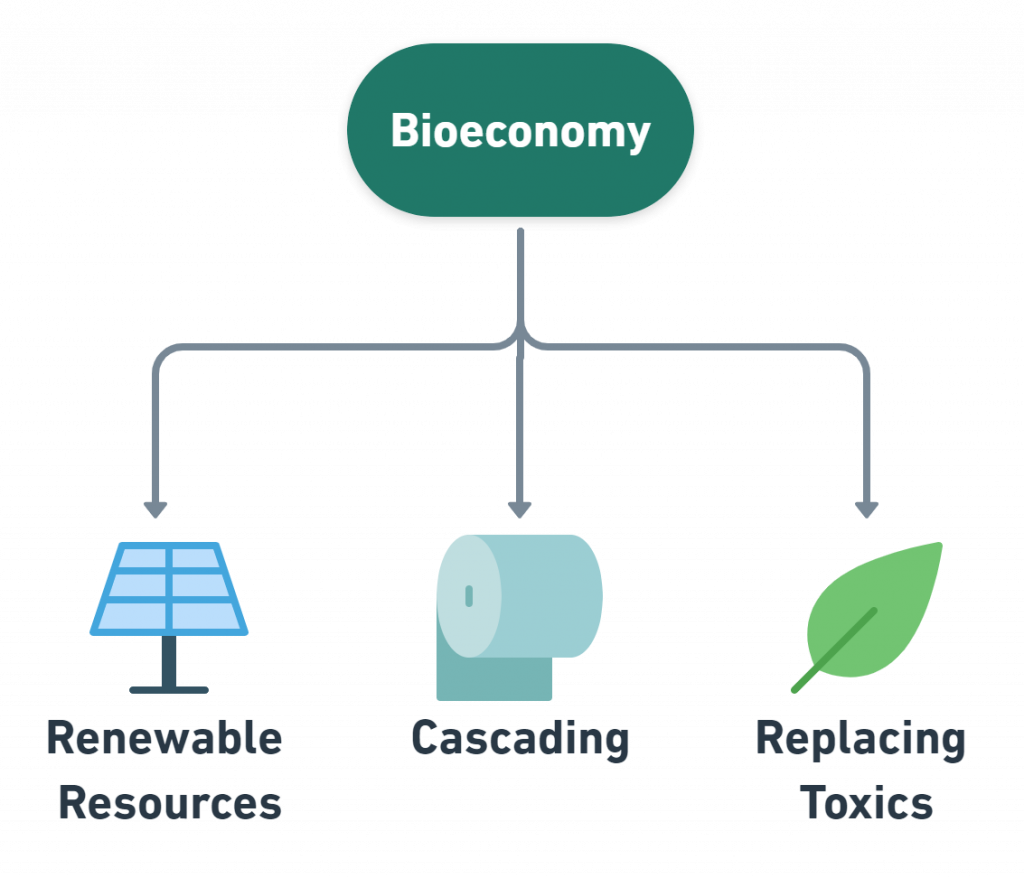
12 tips on how to transition to circular economy
Here follow some important mindsets when transitioning to circular economy. Regardless of actor, behaviour changes are needed as well as cooperation between actors. These tips are inspired by a review of practices for circular economy, in which you can find more information.
Circular Legislation Practices
Legislation practices are extra important in the transition towards a circular society. Without them, companies and individuals do not have the necessary tools to become circular.
- Create standards and metrics – All organizations that apply circular solutions need simple guidelines that help them make choices. A metric or standard should lead to the aims presented in this article.
- Update current laws – There are multiple laws and regulations that make transition to circular solutions hard for companies. Product ownership and waste management are two examples of when current legislation does not allow circular solutions.
- Create economic incentives for companies – Current material legislations are not made for circular material flows. Therefore, circulation of materials is more expensive for companies than extracting new ones. Increased extraction costs, waste taxes and reduced labor taxes would create incentives for businesses to go circular.
- Raising consumers awareness – Individuals and companies lack information and incentives to become sustainable, or circular. One crucial key to success is to increase transparency of the impact our choices have. And the benefits of circular economy, of course.

Circular company practices
As a company representative, you need to consider both how future regulations can affect your organization as well as your customers. The following tips can come in handy in that process.

- Invest in knowledge – Before an organization starts to implement new business models, it is important to understand the opportunities and challenges for the sector in which it operates. Before starting, it is important to investigate what the potential is to save resources and gain value from circular business models.
- Be open for disruptive innovation – To succeed with circular business models, sometimes a disruptive organizational change is crucial. Be open for new solutions and try to understand how they affect your business in the long run.
- Cooperate with other companies – To make material flows circular and secure high material quality, transparency is needed throughout the supply chains. Cooperation and trust are thus often referred to as crucial components of circular economy.
- Be prepared for digitalization – This is another crucial component of circular systems. If a company wants to sell services instead of products they need digital tracking systems to keep track of their products, for instance. Likewise, digitalization is needed to keep transparency through different steps of the supply chain.
Living circular
For individuals, circular economy has potential to both make life easier and puts ease on the environment. But where should you start? Here are four tips on what you can do to live circular:

- Ask yourself: Do I need this, or do I want this? – The most effective way to reduce resource demand is simply by not consuming. So, before buying things, always ask yourself: is this something I need or something I want? If it’s not something you need, consider not buying it. Otherwise you can…
- Buy second hand – Sure, it can be complicated to buy second hand sometimes. The most tricky part is to find what you are looking for. My advice, try to exchange your buyers high to a finders high…
- Be curious and critical – Almost every time you spend money on something, it has an effect on the environment. It is not always clear what the effects are, so be curious and try to consider all negative effects.
- Vote circular –A transition to circular economy requires money in the right places. Politicians play an important role in channeling money in the right direction, so try to find political parties that are ready to explore the benefits of going circular!
4 challenges to reduce environmental impact
Sometimes a solution intuitively feels sustainable. Or organizations use their investments in what seems sustainable to earn money. But when environmental effect is evaluated, it often shows that the result depends on many things and that it is not clear if environmental performance is improved. There are a couple of phenomena you have to be aware of when assessing sustainability and to avoid greenwashing:

- Rebound-effect – This effect is really tricky. You might think that when a process is optimized and products are manufactured with higher efficiently, environmental impact is reduced. What often happens though, is that somewhere in the supply chain money is saved. And that money is spent on other things instead. If that investement causes emissions or pollution, the advantages are countered.
- Burden shifting – When assessing environmental impact, it is too complicated to regard all effects from a given product or service. Therefore, the results depend on how so called system boundaries are chosen. The effects within a certain area or time frame might be positive, but negative on other locations or in the future.
- Lock-in effects – Investing in sustainability is great, but if wrong solutions are chosen, it can be hard to change the system later. This is called lock-in effects and can be exemplified with incineration plants that are common in scandinavian countries. Whole industries become dependent on burning materials that could have been used for better purposes.
- Existing systems are efficient – Many years of large investments in a linear economy has created streamlined supply chains with small amounts of production waste. New, unoptimized small scale solutions can have difficulties to compete with that and result in higher impact, initially.
Summing up
A transition to circular economy means change in basically every sector on every level. This list could be made much longer, but I have chosen the information I feel is most important. However, the list is not set in stone and if you have suggestions for additional aspects that should be in, feel free to comment! If you want to learn more about circular economy, sign up for the newsletter!
